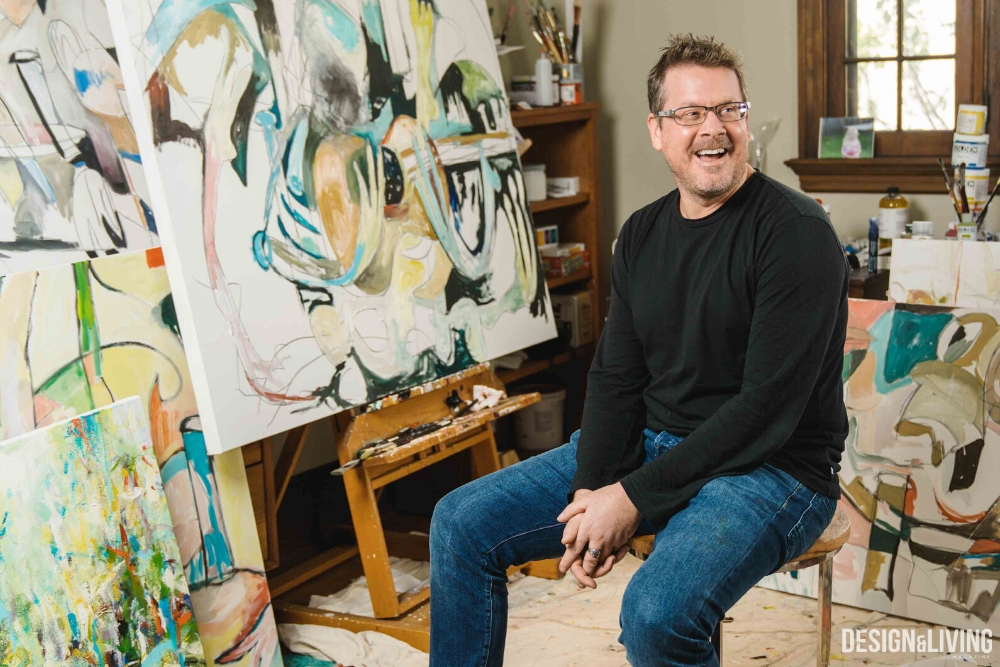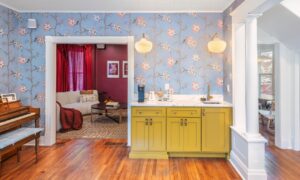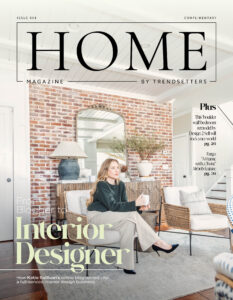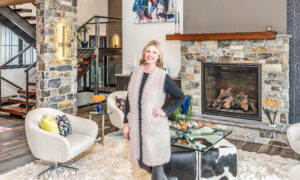Photos by Hillary Ehlen
Ryan Fritz
ryanfritzart.com
[email protected]
From football quarterback to CEO to abstract painter, Ryan Fritz has done it all. Those in the community might recognize Fritz as the friendly and outgoing CEO behind Office Sign Company, a business that does exactly what its name implies. By day, he oversees the creation of contemporary and professional office signage and facilitates a positive company culture. But after hours, he returns to his house full of girls (his partner Amy and him share a blended family of four daughters) and grabs his paintbrushes.
Fritz creates colorful, large-scale abstract paintings. When asked to describe his work, he paused and thought, before trying to put into words what he depicts on his canvases. He used the words “unexplainable,” “unpredictable,” “chaotic” and “very free” before concluding with, “I don’t think I’ve ever tried to define my work.”
Join us as we explore his home and what adorns it and pull your own interpretations of his vibrant, abstract pieces.


A Family Effort
As you enter into the home from the garage, you see two pieces of art hanging on opposing walls. One is a marigold abstract piece by Fritz. On the opposite wall hangs a self-portrait collaged out of purple and yellow construction paper, made over a decade ago by his eldest daughter.
The juxtaposition between Fritz’s abstract canvases and the just as abstract pieces from his children are seen throughout the house. His studio is full of a mix of finished work, in-progress pieces and canvases painted on by his youngest daughter, Rowen. For a period of time, Fritz ran a business called Fargo Kids, where he created custom prints, recreating children’s artwork. “Young drawings really inspire me,” he said while standing in his youngest daughter’s bedroom, admiring the surroundings.
Ryan and Amy’s family is a clear influence on the work he produces. Rather than having a separate studio away from the family, his workspace is doorless and little Rowen often joins him in creating. He jokes that he often works late at night when it is finally quiet in his household, but you can tell he doesn’t really mind the chaos.


A Home Full Of Art
“You can see, the house is filling up with artwork,” Fritz said with a laugh. It’s true. Beyond the pieces hanging on the walls (which we can thank Amy for installing), are pieces propped up along the baseboards, stacks canvases high of partially completed works and, of course, a living room-turned-studio overflowing with pieces. Through the kitchen is a corridor that leads to the formal dining room in one direction and a staircase in the other direction. But straight through is the entrance to what he has made his home studio. This hallway frames the colors and canvases that await once you fully enter the room, and if the canvases weren’t covered with stunning art, it would almost look messy. “When I come by and I look in there, it does give me a sense of joy. There’s something with the chaos,” Fritz said.
While Fritz’s own work adorns many of the walls in the home, he has quite the collection of other artwork displayed. From pieces by his good friend, Punchgut, to graphic designs from Jeff Knight (Cereal), to prints of John Singer Sargent’s work to cartoon-esque prints of beloved fictional characters (Chewbacca, Daredevil and Totoro hang in the basement). He surrounds himself with work from artists he finds inspiring, but who operate in very different artistic styles. He also collects pieces that he just plain enjoys, noting that the Fantastic Mister Fox print in his studio might not be considered “art,” but he just enjoys it.




(Right) Fritz has begun embracing collecting pieces from other local makers, such as this print from Jeff Knight of Cereal.
From The Field to The Office to The Easel
About his school experiences, Fritz shared, “I was pretty athletic. I was pitching on the baseball team and I was the quarterback. I think it was too much pressure to be a leader, so I’m like, I’m just going to focus on my art. This introvert and extrovert relationship. I’m the captain, or I can be in my room downstairs at my parents’ house drawing cool stuff. I think I found more joy in that.” In the decision between athletics and art, Fritz started down the art path, quitting his teams. While he has found great success in art now, he said, “That athletic lesson taught me to not quit.[…] I’m never going to give up on something again.”
Fritz shared that when he tried to turn his work commercial, it simply wasn’t as enjoyable. The pressure to create something for a client disrupted his process and he found he wasn’t as loose. “There’s a lesson in there somewhere, of just have fun and be yourself and that’s when the work turns out the best. The least amount of pressure I put on myself, the better.”
By separating his day job from his art, he can relieve the pressure of feeling he has to make monetizable art or art that is guaranteed to be liked by the masses. Instead, he can create what he wants. “Without the art, I think the business side is impossible. It’s kind of like if your brain is full of air pressure, it’s like a PSI letting it all out,” he said. It is the chaos of his work/art balance that makes his work unique and it’s the chaos that provides him a muse.


From Hyperrealistic to Abstract
Fritz wasn’t always creating colorful, large-scale canvases. In fact, he used to create much the opposite. For some time, he created hyperrealistic pieces, often with football action shots as the subjects.
“For me, art has changed. When I was younger, it was like, what can I make that people will like? And I did love sports at the time and I loved the Cowboys and it was like, this would be cool. I think that was the inspiration back then,” he said, adding, “Back then, I used to think that artists that could do photorealistic stuff were where it was at.” He noted that he fell into a trap of creating work he could guess people would like.
“I felt like I was a technician. Like, here was this photo, and sometimes I could change the background so I wasn’t using the exact photo, but I just didn’t feel like an artist. I felt like a technician,” he said. Shifting focus, his abstract work allows him the freedom to not strive to create the perfect replica. With no reference material or no guide telling him where what colors should go, he can just create.
When he was in the height of creating his photorealistic work, he was working in the small town of Gwinner, N.D., with nothing to do but to go back to his apartment and paint. “I think that’s how some of the photorealistic stuff came about because I was like, I have all this time,” he said. Now with young daughters and a booming business on his hands, his nights don’t quite look like returning to a small apartment and preparing dinner-for-one alongside an easel. Potentially out of necessity, his work no longer showcases the carefulness of airbrush stencils and capturing jersey wrinkles, but rather big sweeping charcoal outlines and blotches of color dancing within the bounds.
With a history of creating identifiable forms and portraits, the transition to abstract pieces was a lawless territory. “When I make abstract art, it’s like, is this done? Should I put a background on it? So then you have 100 paintings in your house that are not complete. I think that is the struggle, especially with abstract work, it’s like, when is it done?” Often, a piece is not done until it leaves the home and can physically no longer be worked on. There are even quite a few pieces hanging in his home that Fritz declares are incomplete.

Before he dove into abstract art, Fritz created hyperrealistic works, especially of football scenes, like this in-progress Joe Montana painting.

From the hyper-realistic Marilyn Monroe piece to the grittier Johnny Cash piece, Fritz said, “That kind of shows a transition into rough and gritty and that I didn’t care if it looked perfect or if the proportions were exact.”
The Mentor
Instrumental in his journey with abstract art is Marjorie Schlossman. Most Wednesdays, you can find Fritz painting alongside Schlossman at her Plains School of Abstract Painting courses. As Fritz continuously brings up Schlossman when discussing his work, it’s clear that she is his mentor.
Schlossman has helped Fritz uncover who he is as an artist and develop his craft. Their relationship came about with a bold move by Fritz, reaching out to her via Facebook and, somewhat jokingly, requested she mentor him. Surprisingly to Fritz, she responded with an invitation to her classes. At first, he was nervous to attend her classes, as she is a renowned artist in our area. “There was a little bit of fear, I like that though, to step out and be uncomfortable. So I grabbed my brushes and paints and I went.”
To this day, he continues to study under her and soak in her knowledge. His admiration for this mentor plays a big part in the work he creates, even if that inspiration comes from a rebellious spirit of doing something he knows she wouldn’t do herself.
Trading in pigskin for stretched canvas, artist, family-man and businessman Ryan Fritz has showcased how diverse his abilities are. Already having covered a lot of ground professionally, who knows what else he will surprise us with next. All we know is that we can’t wait to see it.













